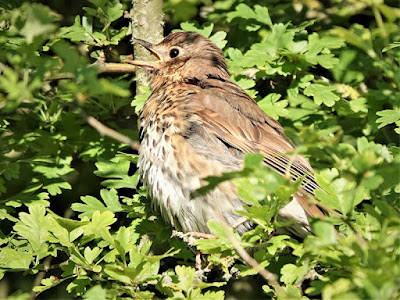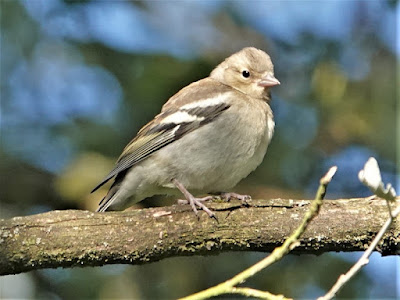11.0°C > 15.0°C: A few clouds soon cleared. Sunny for a while with more cloud developing. Light westerly breeze. Very good visibility.
Sunrise: 05:03 BST
* = a species photographed today
! = a new species for me here this year
!! = a new species for me in Shropshire
Another busy day mostly doing other things so again just the numbers with a few notes. Probably the same tomorrow.
Priorslee Balancing Lake: 05:00 – 06:05 // 07:10 – 08:45
* = a species photographed today
! = a new species for me here this year
!! = a new species for me in Shropshire
Another busy day mostly doing other things so again just the numbers with a few notes. Probably the same tomorrow.
Priorslee Balancing Lake: 05:00 – 06:05 // 07:10 – 08:45
(153rd visit of the year)
Bird Notes
*Best today were two Shoveler duck seen early only. An unusual date for this species here. I usually only record it on Spring or Autumn passage or as an occasional Winter visitor when other locations might be frozen over.
Other bird notes:
- the additional pair of Mute Swans was again present throughout. One pair, and I am not sure which, were often well apart.
- an Oystercatcher flew around at 05:35 but did not visit.
- 35 Black-headed Gulls and seven Lesser Black-backed Gulls appeared overhead at 05:15 probably leaving the football field. At 05:50 there was just 27 Black-headed Gulls and no Lesser Black-backed Gulls on the football field.
- *one Great Crested Grebe juvenile was seen in the water alongside the parent. There does seem to be just the one juvenile.
- 12 Swifts flew off West at 05:05. Two were over the dam area at 05:15. No others were seen.
Counts of birds noted flying over:
- 5 Canada Geese: outbound together
- 6 Feral Pigeons: together
- 2 Stock Doves: together
- 74 Wood Pigeons
- 1 Oystercatcher
- 10 Lesser Black-backed Gulls
- 15 Jackdaws
- 20 Rooks
Hirundines etc. noted:
- 14 Swifts: see notes
- 1 Barn Swallow
- 2 House Martins
Warblers noted (the figure in brackets relates to birds heard singing):
- 10 (6) Chiffchaffs
- 9 (6) Reed Warblers
- *6 (1) Blackcaps
'nominal' warbler:
- 1 (1) Goldcrest
Counts from the lake area:
- 4 Canada Geese: arrived
- 4 Mute Swans
- *2 (?♂) Shoveler
- 16 (?♂) Mallard
- 5 + 4 (1 brood) Moorhens
- 23 + 6 (4 broods) Coots
- *4 + 1 (1 brood) Great Crested Grebes
- 4 Black-headed Gulls: also at least 35 on the football field
- no Lesser Black-backed Gull: but at least seven on the football field
- 1 Grey Heron
Noted on the street lamps poles pre-dawn:
Spiders etc.:
- 1 harvestman: female Leiobunum rotundum
Noted later:
Another abbreviated visit. Though sunny still too early for many insects
- 1 harvestman: female Leiobunum rotundum
Noted later:
Another abbreviated visit. Though sunny still too early for many insects
Butterflies:
- *Green-veined White Pieris napi
- Ringlet Aphantopus hyperantus
- *Meadow Brown Maniola jurtina
- *Green-veined White Pieris napi
- Ringlet Aphantopus hyperantus
- *Meadow Brown Maniola jurtina
Moths:
- Common Marble Celypha lacunana
- Shaded Broad-bar Scotopteryx chenopodiata
- Common Marble Celypha lacunana
- Shaded Broad-bar Scotopteryx chenopodiata
Bees, wasps etc.:
- Buff-tailed Bumblebee Bombus terrestris
- Buff-tailed Bumblebee Bombus terrestris
Hoverflies:
The first name is that used by Stephen Falk. The name in square brackets is that given by Obsidentify or other sources if different. Scientific names are normally common. The species are presented in alphabetic order of those scientific names.
- *Bumblebee Blacklet Cheilosia illustrata [Bumblebee Blacklet]
- Marmalade Hoverfly Episyrphus balteatus
- Chequered Hoverfly Melanostoma scalare [Long-winged Duskyface]
- *Common Dronefly Eristalis tenax
- *Bumblebee Blacklet Cheilosia illustrata [Bumblebee Blacklet]
- Marmalade Hoverfly Episyrphus balteatus
- Chequered Hoverfly Melanostoma scalare [Long-winged Duskyface]
- *Common Dronefly Eristalis tenax
Damsel-/dragon-flies:
- Common Blue Damselfly Enallagma cyathigerum
- Blue-tailed Damselfly Ischnura elegans
- two different unidentified dragonflies
- Common Blue Damselfly Enallagma cyathigerum
- Blue-tailed Damselfly Ischnura elegans
- two different unidentified dragonflies
Other flies:
- Thick-headed Fly Sicus ferrugineus [Ferruginous Bee-grabber]
- other unidentified flies
- Thick-headed Fly Sicus ferrugineus [Ferruginous Bee-grabber]
- other unidentified flies
Bugs etc.:
- none
- none
Beetles:
- Common Red Soldier Beetle Rhagonycha fulva
- *unidentified beetle
- Common Red Soldier Beetle Rhagonycha fulva
- *unidentified beetle
Molluscs:
- White-lipped Snail Cepaea hortensis
- White-lipped Snail Cepaea hortensis
Spiders etc.:
- *wolf spider Pardosa sp.
- *wolf spider Pardosa sp.
Plants:
- the first Blackberry ripe-enough to eat!
- the first Blackberry ripe-enough to eat!
Another mostly cloudy dawn sky to the East.
Looking West was more promising.
By the time I arrived at The Flash it was almost cloudless: for a while.
Only seen c.05:15 were these two Shoveler duck. The large bill of this species is best seen on the left-hand bird.
Not too easy to see with the reflection of the vegetation in the water. The Great Crested Grebe seems to have just one juvenile. The juvenile was in the water briefly but climbed back on the adult's back.
A juvenile Blackcap peering out. Juveniles of both sexes have brown caps like adult females.
What I assume is the proud(?) father.

Juvenile joins dad on the branch...
...and looks around for food.

A different juvenile from the same brood.
A Song Thrush soaking up the early sun. Note the yellow around the gape line indicating this is a juvenile.
A Green-veined White Pieris napi . This is a worn example and the 'green-veins' that are not green and best seen on the underwing are not apparent here. The shape of the black area at the wing tip is the most reliable way of separating the three 'whites': Green-veined; Small and Large. It can be tricky to gauge the size of a Large White when it is on its own. This is a male: female of all three species differ from males in also having a black dot in each hind wing.
A Song Thrush soaking up the early sun. Note the yellow around the gape line indicating this is a juvenile.
A female Chaffinch posed for me at the West end yesterday. Here is one from the East end.
"Is this my best side?"
A Green-veined White Pieris napi . This is a worn example and the 'green-veins' that are not green and best seen on the underwing are not apparent here. The shape of the black area at the wing tip is the most reliable way of separating the three 'whites': Green-veined; Small and Large. It can be tricky to gauge the size of a Large White when it is on its own. This is a male: female of all three species differ from males in also having a black dot in each hind wing.
A Meadow Brown butterfly. This is a female with the contrasting paler area surrounding the black circle containing a single white dot. Males have an almost concolorous wing, also with the black circle containing a single white dot. Soon to be flying is the smaller but otherwise similarly coloured Gatekeeper. The easiest distinction is that the Gatekeeper has two white dots in the forewing's black circle.
A Common Dronefly Eristalis tenax. Just look at the length of its tongue. Perhaps it could obtain employment as a Gene Simmons replacement in any reformed Kiss?
The best I could do with the photo editor to isolate what is clearly a beetle. Obsidentify thought it was a froghopper species and the Seek app. thought it a weevil. It is neither of those. Further than that I cannot go.
(Ed Wilson)
In the Priorslee Avenue tunnel:
(Ed Wilson)
------------------------------------------------------------------------------------------------------
In the Priorslee Avenue tunnel:
Moths:
- *1 Single-dotted Wave Idaea dimidiata
- *1 Single-dotted Wave Idaea dimidiata
(Ed Wilson)
------------------------------------------------------------------------------------------------------
The Flash: 06:10 – 07:05
(156th visit of the year)
Bird notes:
- two Mallard were seen sitting on a roof-top in Wordsworth Way. I have not seen any on roofs for several weeks.
- juveniles were heard calling from underneath the Coot noted as still sitting yesterday.
Bird(s) noted flying over here:
None
Hirundines etc. noted:
- 2 Swifts
Warblers noted (the figure in brackets relates to birds heard singing):
- 2 (2) Chiffchaffs
- 4 (3) Blackcaps
'nominal' warbler:
- 1 (1) Goldcrest
Noted on / around the water:
- 218 Canada Geese
- 62 Greylag Geese
- 1 Canada x Greylag Goose
- 2 + 3 (1 brood) Mute Swan
- 20 (?♂) Mallard
- 19 (?♂) Tufted Duck
- 5 Moorhens: no juveniles specifically noted
- 52 + 8 (7 broods) Coots
- 5 Great Crested Grebes
Noted elsewhere around The Flash:
Hirundines etc. noted:
- 2 Swifts
Warblers noted (the figure in brackets relates to birds heard singing):
- 2 (2) Chiffchaffs
- 4 (3) Blackcaps
'nominal' warbler:
- 1 (1) Goldcrest
Noted on / around the water:
- 218 Canada Geese
- 62 Greylag Geese
- 1 Canada x Greylag Goose
- 2 + 3 (1 brood) Mute Swan
- 20 (?♂) Mallard
- 19 (?♂) Tufted Duck
- 5 Moorhens: no juveniles specifically noted
- 52 + 8 (7 broods) Coots
- 5 Great Crested Grebes
Noted elsewhere around The Flash:
Moths:
- *2 Tawny Grey Eudonia lacustrata
- *1 Small Fan-footed Wave Idaea biselata
- *1 Clouded Border Lomaspilis marginata
- *2 Tawny Grey Eudonia lacustrata
- *1 Small Fan-footed Wave Idaea biselata
- *1 Clouded Border Lomaspilis marginata
Flies:
- 1 owl midge Psychodidae sp.
- 1 owl midge Psychodidae sp.
Bugs:
- *1 Red-legged Shieldbug Pentatoma rufipes
- *1 Red-legged Shieldbug Pentatoma rufipes
Beetles:
- several Alder Leaf Beetles Agelastica alni : adults
- several Alder Leaf Beetles Agelastica alni : adults
One of two 'grey' moths. This one too worn to give a positive ID: I think (yet another) Tawny Grey Eudonia lacustrata
A Small Fan-footed Wave moth Idaea biselata.
A smart-looking moth: a Clouded Border Lomaspilis marginata on a street lamp pole at the top end.
(Ed Wilson)
------------------------------------------------------------------------------------------------------
Sightings from previous years
2012
Priorslee Lake
Common Tern
Possible Otter
(Ed Wilson)
2011
Priorslee Lake
A female Ruddy Duck
(Ed Wilson)
2006
Priorslee Lake
A drake Ruddy Duck
(Ed Wilson)
2005
Priorslee Lake
Common/Arctic Tern
(Martin Adlam)






















